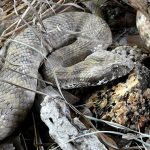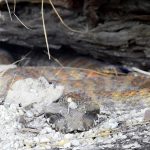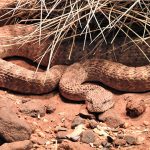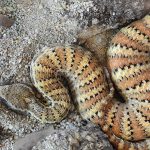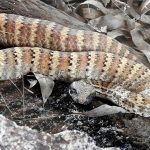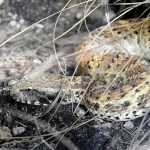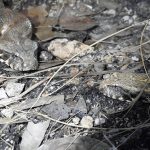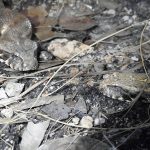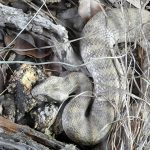DEATH ADDER
The Common Death Adder
In the dense underbrush of Australia’s eastern forests, a master of disguise lies in wait. The common death adder, Acanthophis antarcticus, is a venomous snake renowned for its ambush hunting style and exceptional camouflage.
Physical Characteristics
Appearance: This snake boasts a broad, flattened, triangular head and a thick, stocky body adorned with bands of red, brown, and black, complemented by a grey, cream, or pink belly.
Size: Adults typically measure between 70 to 100 centimetres in length, with females generally being larger than males.
Tail: A distinctive feature is its thin, curved tail, which it wiggles to mimic a worm, luring prey close enough for a swift strike.
Habitat and Distribution
Range: The common death adder is found across much of eastern and coastal southern Australia, including Queensland, New South Wales, Victoria, and South Australia.
Preferred Environments: It inhabits forests, woodlands, grasslands, and heathlands, often favoring areas with abundant leaf litter or forest debris for concealment.
Behaviour and Diet
Hunting Strategy: Unlike many snakes that actively pursue their prey, the common death adder employs an ambush technique. It buries itself under leaf litter, exposing only its head and tail. The tail’s movement attracts prey, which the snake strikes with remarkable speed upon approach.
Diet: Its diet includes small mammals, birds, lizards, and frogs.
Venom and Human Interaction
Venom: The common death adder’s venom is highly toxic, containing neurotoxins that can cause paralysis. However, fatalities are rare due to the availability of antivenom and prompt medical treatment.
Human Encounters: While not aggressive, the snake’s reliance on camouflage means it may remain motionless when approached, increasing the risk of accidental bites.
Conservation Status
Threats: The common death adder faces threats from habitat loss and the spread of invasive species like the cane toad, which preys on juveniles and can be fatal if ingested by adults.
Conservation Efforts: Despite these challenges, the species is currently listed as of “Least Concern” by the IUCN Red List, indicating a stable population.
- Like all Australian native reptiles, the Death Adder is protected under wildlife conservation legislation in Australia.
Fascinating Facts
Lifespan: Common death adders can live up to 15 years in the wild.
Reproduction: Unlike many reptiles, they give birth to live young, with litters ranging from 3 to 20 offspring.
The common death adder’s unique adaptations and behaviors make it a remarkable example of Australia’s diverse and specialized wildlife.

